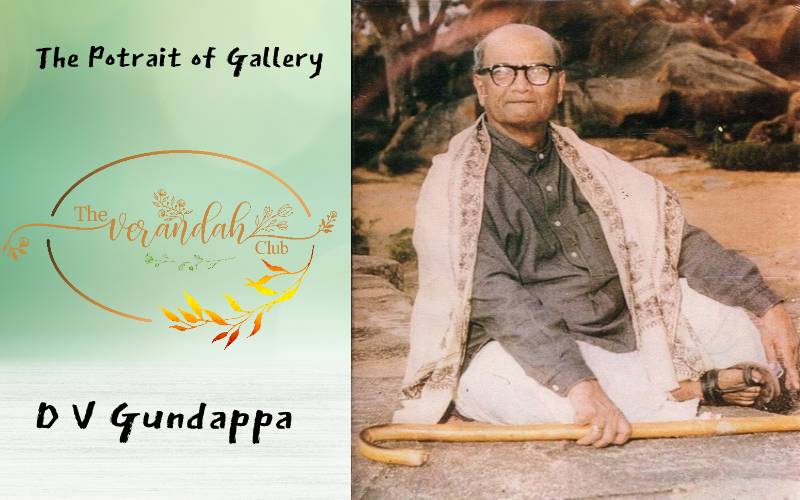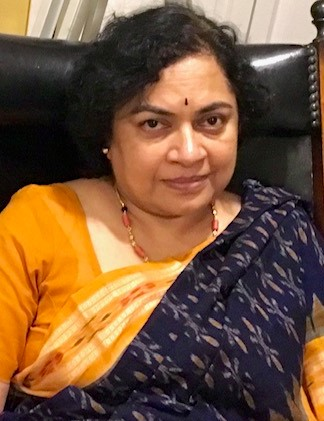
If D V Gundappa, more famously known as DVG, were alive, he would be more than 130 years today. His memory lives on to this day. There must be thousands of admirers, including me, who thumb through his classic ‘Manku Timmana Kagga’ for inspiration and guidance on life. Many carry the book in their pockets and handbags for ready reference. ‘Kagga’ is the oracle for all problems you face in life.
“I follow a few talented poets and writers who still tweet about DVG’s ‘Manku Timmana Kagga’ (in DVG’s own words) and follow his style of writing poetry in choupadi. @hmvprasanna, who translates the comic strip Calvin Hobbes into Kannada into choupadis. @Hamsanandi translates Sanskrit poems into Kannada. @santalum_aurum is translating DVG’s 'Kagga' into English verse. There are many other talented writers and poets in English, Kannada, whose efforts are clearly inspired by DVG. I am as charmed and inspired by fellow admirers as DVG himself.”
DVG was born in a Tamil-speaking Brihaccharanam Iyer family, originally from a small village near Trichy. The family migrated to Karnataka about five hundred years back. DVG’s great grandfather was a Sheikdar in a Mulbagal, a small town near Kolar. Young Gundappa was named after his great grandfather. He grew up under the care of his granduncle Ramanna and uncle Timmappa. DVG loved and admired his sage-like mother and grandmother who knew the epics by-heart and went through many hardships in their lives. The family was very cultured but poor.
DVG’s father, Venkataramanappa and uncle Timmappa were both schoolteachers. DVG loved his uncle very much. The foreword in ‘Kagga’ paints a heartwarming word picture of his uncle, Timmaguru, his first teacher.
DVG has written extensively and emotively about his childhood experiences in his ‘Jnapaka Chitrashale’ (Portrait Gallery in English). His young life was simple, natural, and comfortable. There were festivals, poetry reading, music, and celebrations. DVG's father recited epic stories and classical works like ‘Andhra Bhagavata,’ stories of Manu, Dilip, and Aja. As a boy, DVG absorbed a surfeit of sensory inputs that shaped his mind and intellect.
Kannada Lower Secondary and English Lower Secondary (LS) were the only two exams he could pass. DVG went to Mysore and joined Maharaja's High School. But he could not live there too long. His grandparents passed away, his hometown suffered the plague epidemic, the family suffered heavily due to the failure of crops and other financial losses. But after a while, the family rallied, and DVG returned to school in Kolar. But bad luck continued to plague him. He fell so ill that he could not go back to school. When he did go back, he failed his SSLC exams. DVG had learned deeply from his teachers. Furthermore, his family was highly educated. He continued his education in Sanskrit and languages in an informal fashion.
DVG shifted to Bangalore to look for work. He continued to study Sanskrit, scriptures and philosophy under many stalwart scholars.
By then, DVG was married to Bhagirathamma. His father was ambitious for his brilliant son and tried to persuade him to study law. But DVG wanted to be independent. After trying his hand at several trades and failing, DVG became a journalist for a weekly magazine called ‘Suryodaya Prakashika’ at Navaratna Press. He remained a writer all his life. He would choose to stay independent all his life, repudiating many invitations that promised better financial security. DVG was a journalist, writer, poet, philosopher, public intellectual, activist, and politician. He wrote in English and Kannada.
DVG would go on to work for many magazines and start his own magazines and publications. His uncompromisingly independent stand would create many conflicts. He would even criticize Diwan Visweswariah, his staunch supporter. But Visweswariah's belief in journalistic ethics was unwavering enough that he never once asked DVG to water down his criticism or stop him from writing anything. DVG would go on to write about Sir M Visweswariah in his ‘Jnapaka Chitrashale.’
The Poet-philosopher DVG lost his wife when he was still in his mid-thirties. His three young children, a boy and two girls, were very young at that time. His widowed sister helped him take care of his children. DVG did not marry again. His son, B G L Swamy, would later gain fame and recognition as a botanist and litterateur in his own right.
DVG wrote a series of little character sketches about the famous and obscure people he had interacted with. He wrote these sketches over many years. They were published in various magazines, first as single sketches over the years and then as collections. Seven classified collections were published between 1969 and 1974, titled ‘The People of Refinement and Culture,’ ‘The Artists,’ ‘The Litterateurs,’ ‘The Dewans of Mysore,’ ‘Traditional Men of the Vedas,’ ‘Public Personages,’ ‘The Benevolent.’ Finally, the eighth volume, a complete set of all memoirs and character sketches, was released posthumously in 1977.
This work in itself would be considered a lifetime achievement for anyone. The sketches amounted to 2046 pages of 185 articles. All of them were memoirs based on DVG’s own experiences of meeting people both in public and private life, anecdotes and conversations he was personally privy to, and organizations he had interacted with.
The sketches give a glimpse of the people, places and culture of the times. They capture the zeitgeist of the times about 70-80 years ago. These narratives hold a mirror to the public sentiment of the times, the general likes and dislikes of the people, the emotive hot button issues, and the values that actuated them. In short, a slice of the history of those times is encapsulated in these word pictures.
DVG had an enormous amount of life experience. He knew and closely interacted with the kings, ministers, public intellectuals, and thinkers, to ordinary people living in hamlets on the other, from religious leaders of all hues to followers of every ilk, writing about topics that covered everything, from political unrest to domestic disputes and in between. He covered everything with even-handed but affectionate regard.
D V Gundappa was like the proverbial swan that sucked the milk and left the water behind. It was not as though he did not take note of the lacunae, but they were viewed with sympathy. But the good aspects were noted and extolled. DVG treated these character sketches as a vehicle for imparting life lessons. Who is not guilty of making mistakes or having character flaws? On the other hand, DVG felt that examining a person’s achievements, values, and how he struggled and succeeded in overcoming obstacles is a worthy endeavor and has enormous learning potential.
These stories are relevant even today, even though some sketches are anachronistic enough to seem almost fantastic. But they are unforgettable character sketches vividly narrated through an unbiased, if sympathetic lens. DVG’s ‘Gallery of Portraits’ is a work that has a vast canvas and covers topics that will stimulate both the mind and heart of his readers. They can indeed be described as stories, historical narratives, and character sketches.
Sometimes DVG’s own experiences, and indeed, his personality that shines through these sketches. DVG was a reticent person about his private life. He only spoke about himself when the subjects were irrevocably interwoven with his own experience. DVG has narrated the stories of his experiences with the unknown artists of Mulbagal; Dewan Mirza Ismail and Sir M Visweswariah, the many great and learned people of Bangalore like Bellave Venkatanaranappa and others. We get to have glimpses of DVG himself in these tales.
DVG wrote an introduction to this series to highlight the scope of his sketches. “These sketches are not meant to be a historical analysis. These are, but incomplete line drawings of great men caught from an angle. These may be of some little use for a historian of the times or these lives.” But these modest words understate DVG’s rich life experience.
The title of this series is also very apt. ‘Jnapaka Chitrashale,’ in Kannada, means an Art School of memoirs. The word sketches are in a language fragrant with feeling, loving humor, and engaging narrative style. They are neither too long nor too short. While the narration is subtly infused by a philosophical undertone; there is hectoring. The stories are light and make the reader happy.
DVG’s style is engaging and easy, but at the same time, mature and weighty. His language is light and at the same time comes with the heft of profound scholarship. As I have said many times earlier, his works convey his rich life experience. He could be evocative, but his writing always had the rigor of his deep study.
The Verandah Club is also publishing character sketches of prominent individuals who have made significant contributions in many fields and shaped the lives and fortunes of those around them. Because I appreciate their efforts in this direction, I wanted to write about DVG here. I hope those who are intrigued by this article will pick up ‘Jnapaka Chitrashale.’ They will enjoy reading it as much as I did!
 Manjula Tekal is an author and translator. She has several translations to her credit, including a Kannada translation of Jagmohan's 'My Frozen Turbulence in Kashmir' (published), Babu Krishnamurthy's Ajeya, a biography of Chandrashekhar Azad from Kannada to English (releasing soon.) Her novel, 'Devayani,' is soon to be published by Garuda Prakashana. Manjula holds Master's degrees in management from the Indian Institute of Management, Bangalore (IIM-B), and the University of Illinois at Urbana-Champaign, and an undergraduate degree in Electrical Engineering. Manjula has several years of experience in the field of IT and Management. She has worked both in Industry and Education sectors.
Manjula Tekal is an author and translator. She has several translations to her credit, including a Kannada translation of Jagmohan's 'My Frozen Turbulence in Kashmir' (published), Babu Krishnamurthy's Ajeya, a biography of Chandrashekhar Azad from Kannada to English (releasing soon.) Her novel, 'Devayani,' is soon to be published by Garuda Prakashana. Manjula holds Master's degrees in management from the Indian Institute of Management, Bangalore (IIM-B), and the University of Illinois at Urbana-Champaign, and an undergraduate degree in Electrical Engineering. Manjula has several years of experience in the field of IT and Management. She has worked both in Industry and Education sectors.
NEXT ARTICLE

At the southernmost tip of this mesmerising ensemble lies the majestic Great Nicobar Island, boasting an impressive landmass of about 910 square kilom...

Bharath has always been a land traversed by spiritual masters/ Guru since time immemorial. These spiritual masters have always upheld the core princip...

South India contains its fair share of unique pilgrimage centres. These divine places of worship have a prominent Sthala Purana, devoted followers, di...